Assurance Argument
In its Assurance Argument, the institution describes how it meets each Core Component of HLC’s Criteria for Accreditation and, if applicable, uploads forms or reports for any additional components of its review. The institution may also provide a welcome message for the peer review team in this section.
Coordinators and editors may edit the welcome message and Criteria for Accreditation sections, upload files, and add notes to the scratch pads. Readers may view the text and files, and add notes to the scratch pads.
Welcome Message for Review Team
The welcome message is an optional space where users can provide a brief description of the institution for the peer review team. Users may also choose to upload a photograph or image to personalize the page. It is recommended that this section be kept short as it is designed to provide a brief introduction only.
Add Text
- To expand the section, click “Welcome Message for the Review Team.”
- Click the Edit link.

- Type directly in the text box or copy and paste information from an external document. See Text Formatting below for additional details on entering and formatting text.
- Click the Save button.
- Click “Welcome Message for the Review Team” again to collapse the section.
Upload an Image
Institutions may include a photograph or image in the welcome message. This is the only place in the Assurance Filing where an image may be added.
Image file requirements:
- Accepted file formats: PNG or JPEG
- Maximum file size: 5MB
- The file name can only include certain special characters: hyphen (-), period (.), underscore (_) or plus sign (+). Users will not be able to upload an image that has other special characters in the file name, such as commas, question marks or slashes.
- If necessary, the image will be resized to fit a maximum height of 200 pixels after it is uploaded.
To upload an image:
- Click “Welcome Message for the Review Team” to expand the section.
- Click the Edit link.
- Click the Upload Image button.

- Select the desired file on your computer and click the Open button.
- Click the Save button. The image will appear at the top of the welcome message.
- Click “Welcome Message for the Review Team” again to collapse the section.
Criteria for Accreditation Sections
In the Criteria for Accreditation sections, the institution will provide a narrative describing how it meets the Core Components of each Criterion and link to documents and URLs from the Evidence File to supports its argument. The peer review team will review the narrative and the linked evidence to evaluate the institution’s compliance with the Criteria.
Section Assignments, Dues Dates and Statuses
The Criterion sections include optional project management features to help institutions coordinate the development of the Assurance Argument.
For each Core Component, primary and assistant coordinators can assign contributors, set due dates and track the status of the section. To manage these settings, click “Manage Section” below the Criterion title:

Assign Contributors
- Click “Add” in the Assigned To column for the relevant Core Component. If users are already assigned to the Core Component, click their name to edit the assignment.

- An “Assigning Contributors” window will appear with a list of all the institutional contributors on the left and a list of any contributors already assigned to the section on the right.
- Click the orange arrow next to the contributor(s) you wish to assign to the Core Component section. Their name will move to the list of assigned contributors.
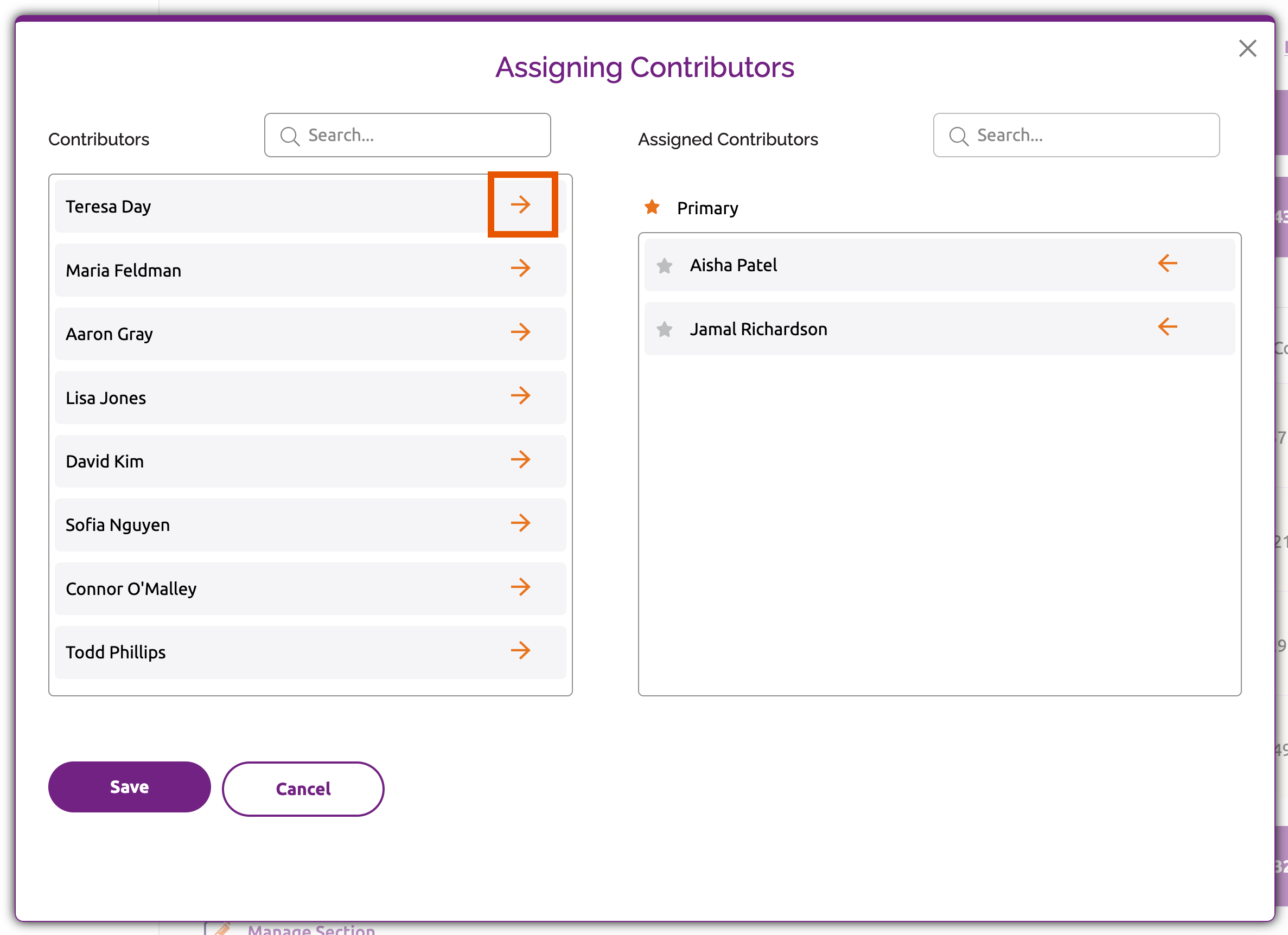
- To remove an assigned contributor, click the orange arrow next to their name. They will be moved back to the list of all contributors.

- To make an assigned contributor the “primary” contributor for a section, click the gray star next to their name. It will turn orange to indicate their primary status. (Note: only one contributor may be assigned as primary per section.)

- Click “Save” to save any changes, or click “Cancel” to discard changes and close the window.
Set Due Date
- Click the date field in the Due Date column for the relevant Core Component.
- Select the date from the calendar.

- Click the “Save” link under the Criterion title to save your changes, or click “Cancel” to discard changes and close the manage section view.
Set Section Status
- Click the icon in the Status column for the relevant Core Component.
- Select the desired status: not started, in progress, in review or submitted.

- Click the “Save” link under the Criterion title to save your changes, or click “Cancel” to discard changes and close the manage section view.
Check Out and Check In Sections
To ensure that users do not overwrite each other’s work, Canopy only allows one user to edit each Core Component section at a time. If a user is editing a particular section, their name will be displayed in the Checked Out By column for that section. Other users will not be able to edit the section until it is checked in.
To check sections out and in:
- Click the title of the Core Component section you wish to edit.
- Click the “Check Out” button. This will make the Evidence File Sources and Argument fields editable.
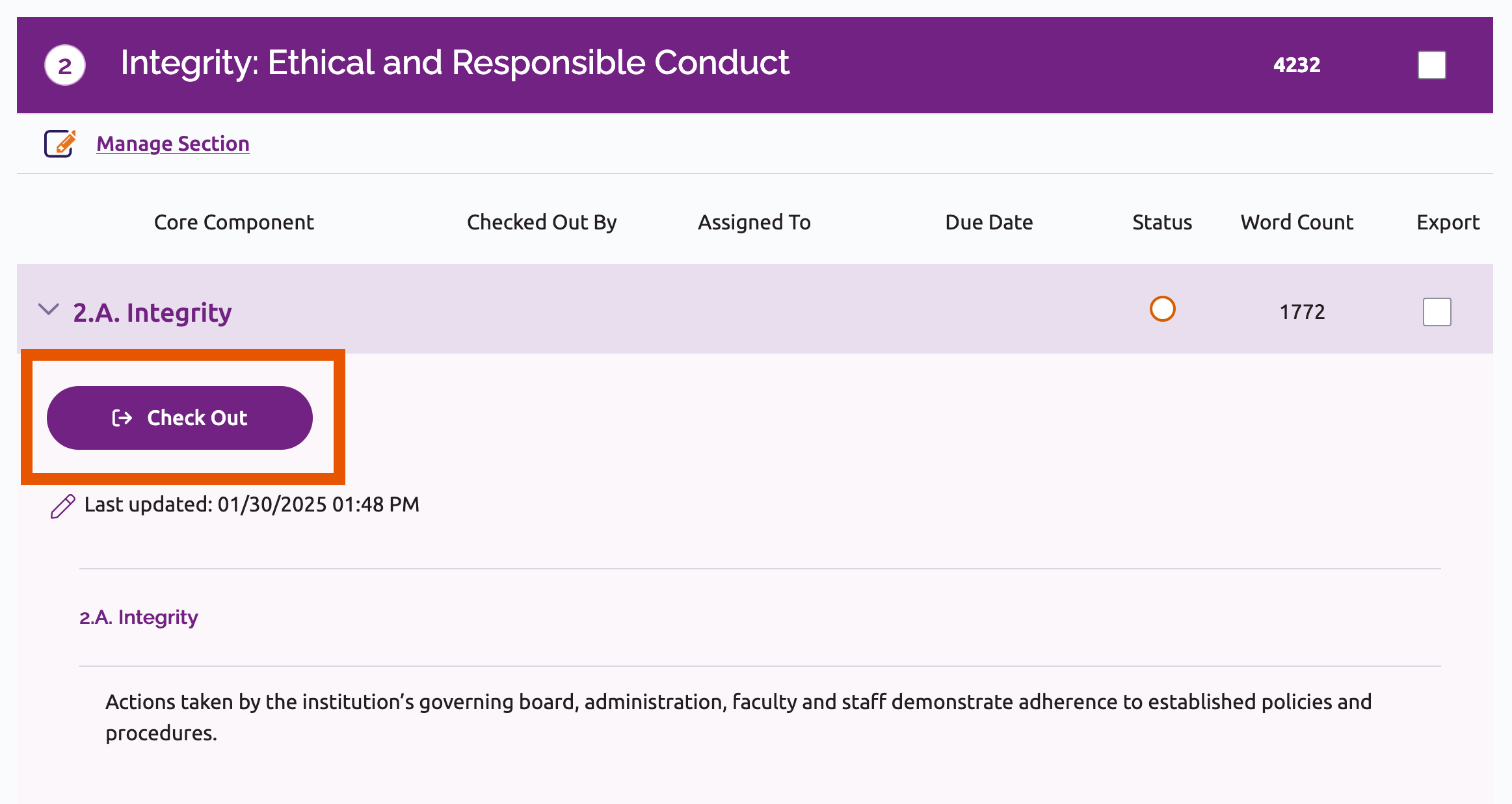
- When you are done making changes, click one of the links at the bottom of the section to save your work:
- “Save and Check In” will save your changes and check the section in so that it can be edited by other users.
- “Save” will save your changes without closing the section. If you wish to close the section but keep it checked out, click “Close” after saving your work.click one of the options at the bottom of section to save your work and/or close the section:
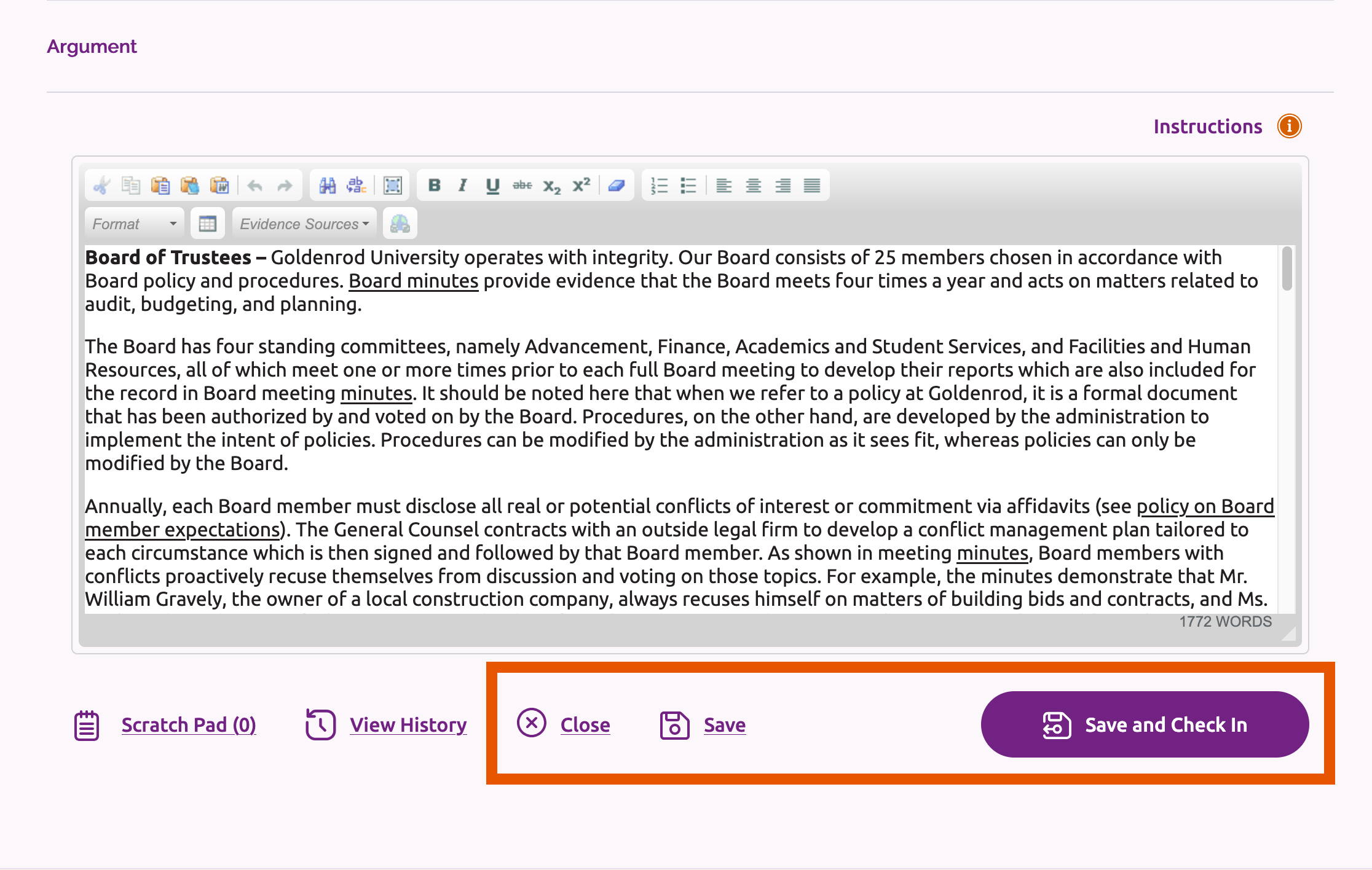
Check In a Core Component That Was Checked Out by Another User
Primary and Assistant Coordinators Only
To check in a section that has been checked out:
- Click “Manage Section” in the relevant Criterion section.
- In the Checked Out By column for the relevant Core Component, click “Check in.”

- The “Check in” link will change to “Check out.” Click the “Save” link under the Criterion section title to finish checking in the Core Component.
Add Text
- Click on the title of the relevant Core Component section and then click the Check Out button.
- The section will display the policy text for the Core Component, as well as fields to enter Evidence File sources (see instructions below) and the Assurance Argument narrative.
- Scroll down to the Argument field to enter the text for the section. Type directly in the text box or copy and paste information from an external document. See Text Formatting below for additional details on entering and formatting text.
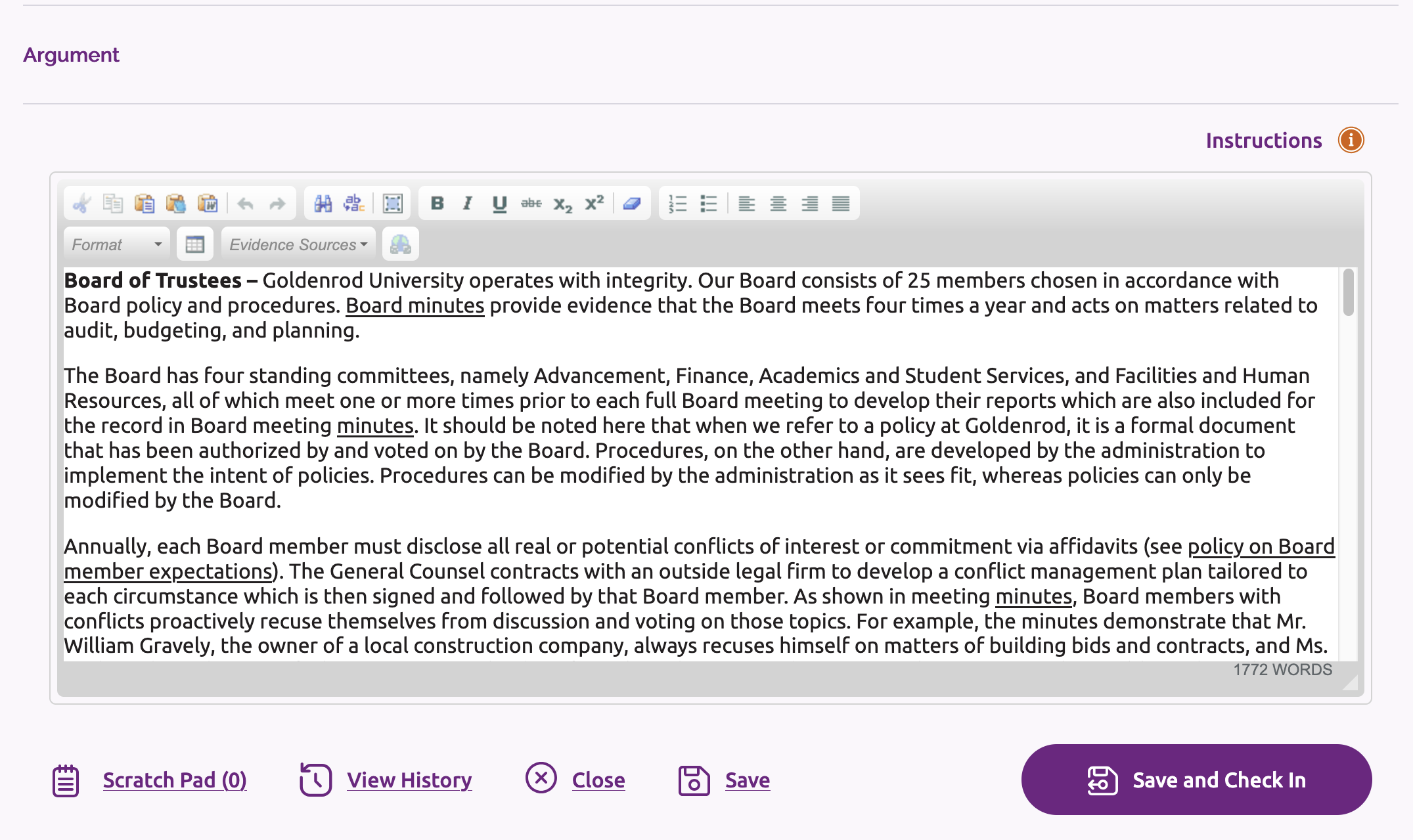
- After the text has been added, click one of the links at the bottom of the section to save your work:
- “Save and Check In” will save your changes and check the section in so that it can be edited by other users.
- “Save” will save your changes without closing the section. If you wish to close the section but keep it checked out, click “Close” after saving your work.
Link to Evidence File Sources
There is a two-step process for referencing Evidence File sources in the Core Component sections and making them accessible for peer reviewers. Complete this process for each section of the Assurance Argument:
1. Add PDF files as sources to sections of the narrative.
Note: The following instructions do not apply to URL sources. URLs entered in the Evidence File are automatically listed in the URL Source List drop-down menu in the toolbar of the Argument field.
- Click the title of the relevant Core Component section and then click “Check Out.”
- Scroll down to the Evidence File Sources section and click the Add Source button.
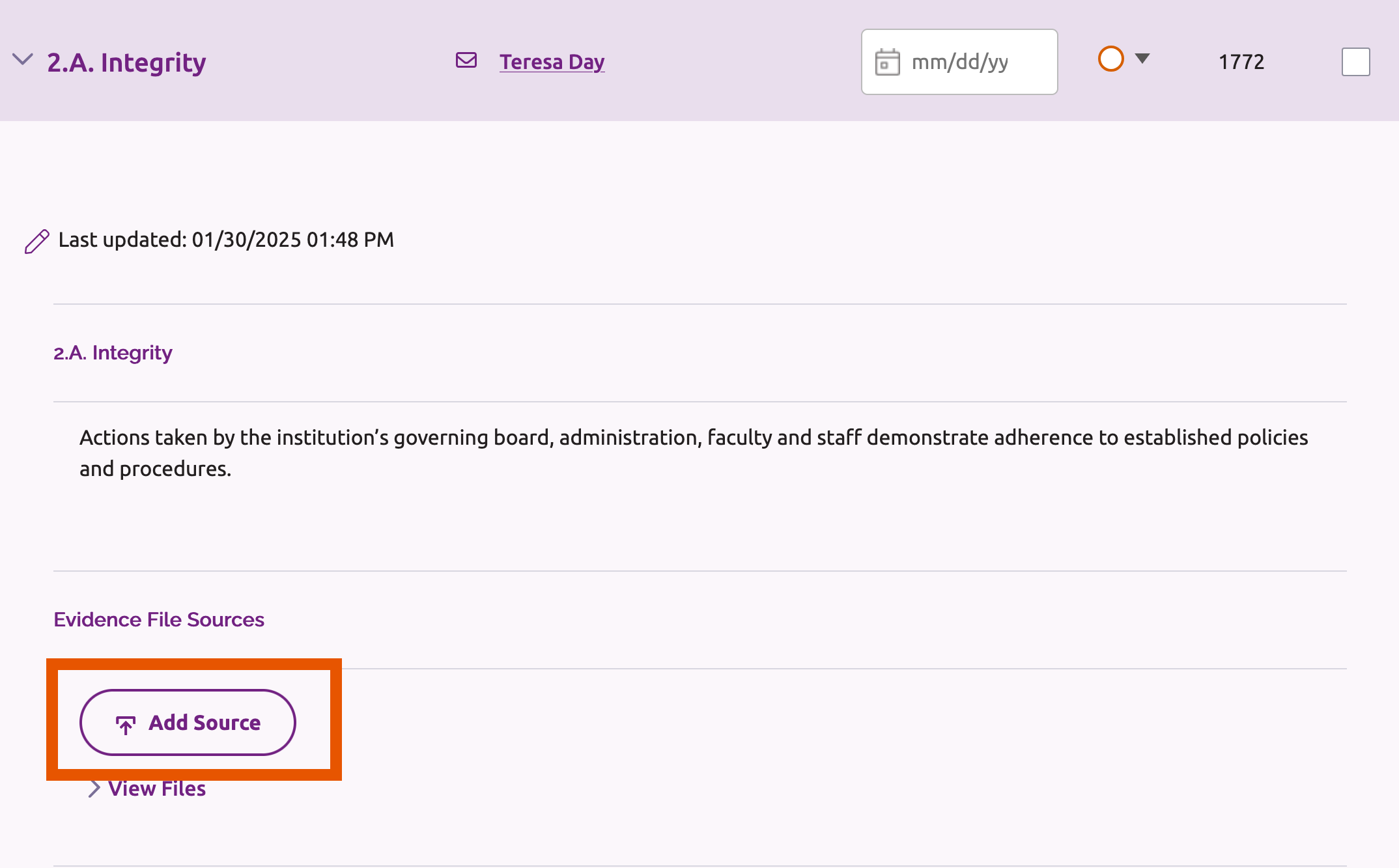
- In the Select File window that opens, you will see the PDF file manager from the Evidence File, displaying the files that have been uploaded.
- Navigate to the file you wish to reference in the Core Component and click on the file name. The Select File window will close and you will see a message confirming that the file has been added.
- Click “View Files” to view and manage the list of sources added to the section.
- Add Page: This function allows users to add a reference to a specific page in a document. The entire document will still be visible to reviewers, but it will open to the specified page when it is linked to the narrative in this fashion. To add a page reference:
- Click “Add Page” next to the file name.
- Enter the desired page number and click “Save.”
- Repeat the above steps to add additional page references for the same document.
- View: Click “View” next to the file name to open the file in a new browser window.
- Delete: Click “Delete” next to the file name to remove the document from the section. Note: this does not delete the document from the Evidence File.
- Add Page: This function allows users to add a reference to a specific page in a document. The entire document will still be visible to reviewers, but it will open to the specified page when it is linked to the narrative in this fashion. To add a page reference:
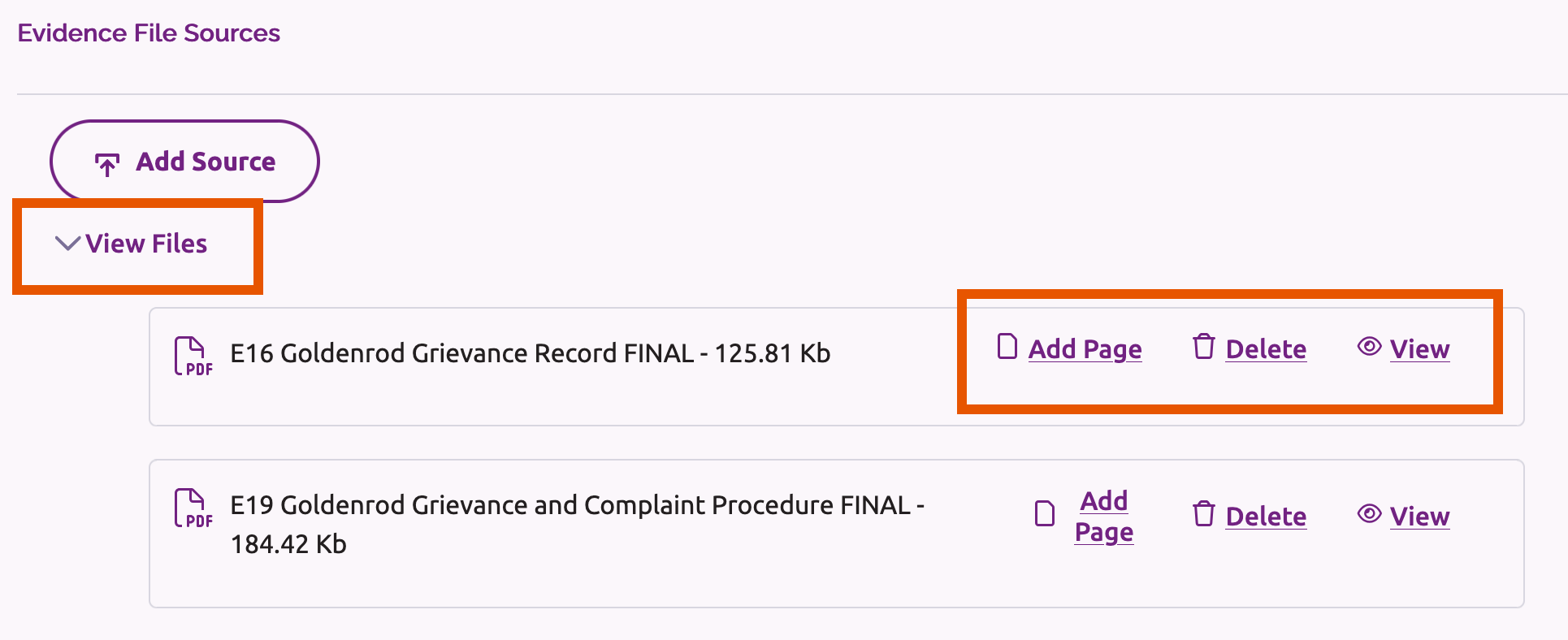
- Continue to add additional documents in this manner. (Documents may be added at any point in the preparation of the Assurance Argument.)
2. Create hyperlinks to specific PDF files and URL sources within the narrative text.
Every document added as an Evidence File source must be linked in the Assurance Argument text in order to be accessible to peer reviewers. To create a hyperlink:
- Check out the relevant Core Component section in order to edit the Assurance Argument text.
- In the Argument field, highlight the word or phrase to be linked to a source or place the cursor at the desired location in the narrative to insert the document’s file name.
- In the toolbar of the Argument field, click on the Evidence Sources button to link to a PDF file (that has been added as a source for the section) or the URL Source List to link to a URL entered in the Evidence File.

- Select the relevant PDF file or URL source from the drop-down menu. The source of evidence will now be an active link within the narrative.
- Page-specific links: When you add a link to a specific page in a PDF file, we recommend including a parenthetical note with the intended page number in the narrative. Page-specific links may function differently depending on a user’s web browser type, version and PDF viewer plugin.
- To remove a link in the narrative, highlight the linked text and then click the Remove Link button.
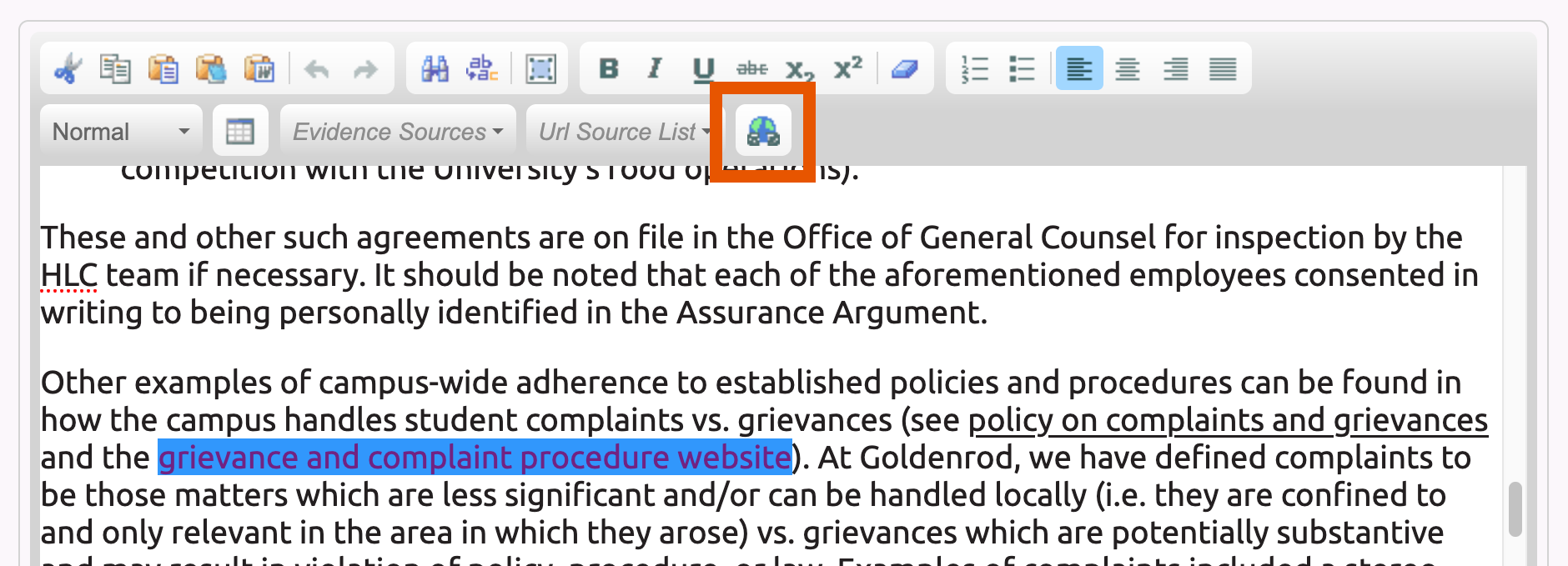
- Click one of the links at the bottom of the section to save your work:
- “Save and Check In” will save your changes and check the section in so that it can be edited by other users.
- “Save” will save your changes without closing the section. If you wish to close the section but keep it checked out, click “Close” after saving your work.
Collaborate With the Scratch Pad
Each Core Component section includes an optional scratch pad, where users can leave notes and collaborate with each other. Notes posted to the scratch pads will be permanently deleted from the system when the Assurance Filing is locked.
Coordinators, editors and readers can view and add notes to a scratch pad at any time, even if the related Core Component section is checked out by another user. Accreditation Liaison Officers and Chief Executive Officers who don’t have another contributor role can view scratch pads, but cannot add notes.
To view and add to a scratch pad:
- Click the relevant Core Component title to expand the section.
- Scroll down to the bottom of the section and click the Scratch Pad link. This will open the scratch pad in the bottom left corner of the screen.
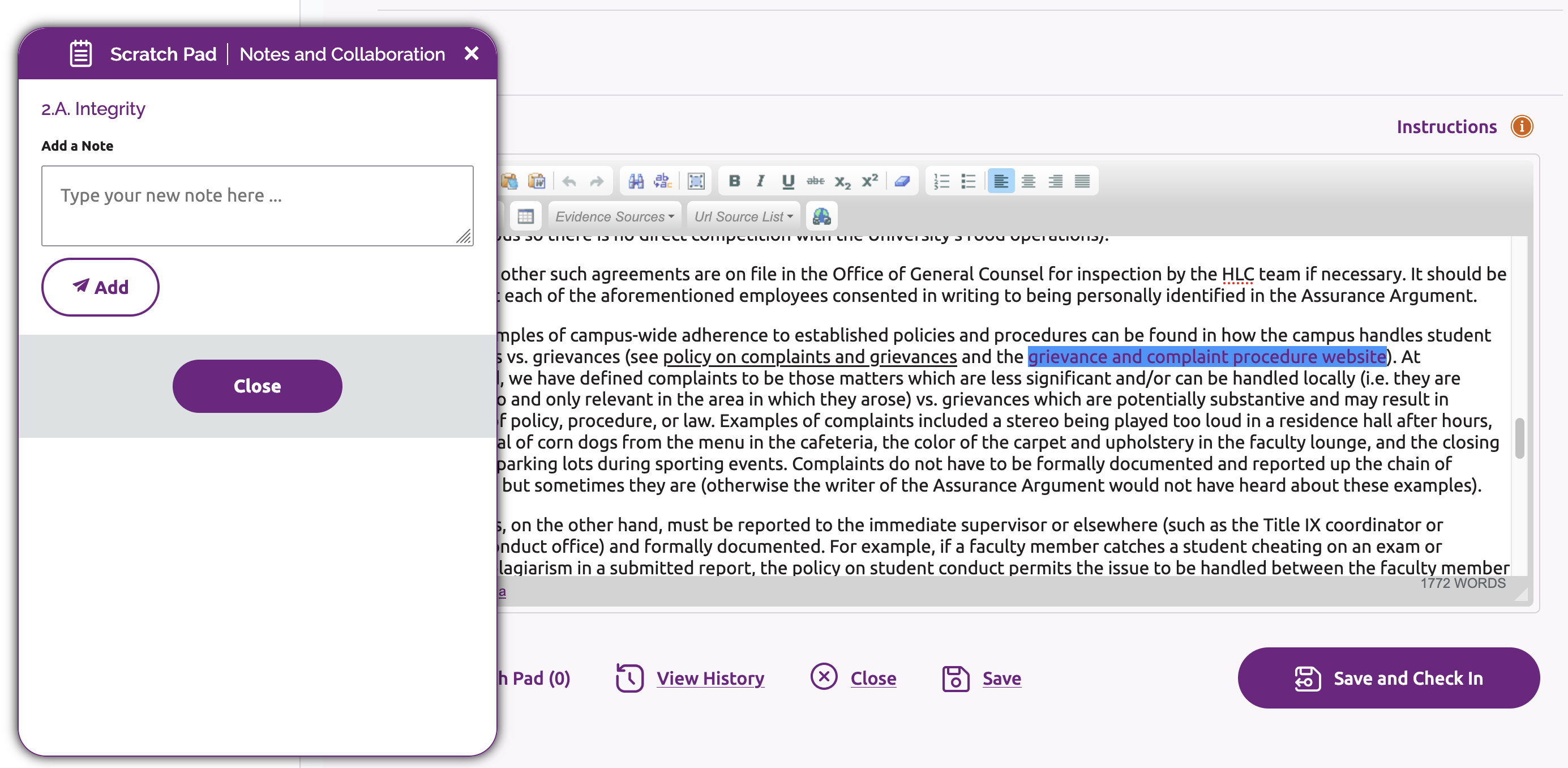
- All notes that have been added to the section’s scratch pad will be displayed.
- To add a note, type your message in the text field and click the Add button.
- Click “Close” to exit the scratch pad.
View History and Archived Versions
All users, including readers, can view the history and archived versions of a Core Component section, even if the section is checked out by another user.
- Click the relevant Core Component title to expand the section.
- Scroll down to the bottom of the section and click the View History link. This will display an Activity Log window, listing all of the changes made to the section, including dates and users.

- To access a copy of a previous version of the section, click “View Archived Version.” The archived version will open in a separate window.
- It is not possible to restore an archived version as-is, but a user may copy and paste text from a previous version.
- To close the Activity Log, click the Close button.
Text Formatting
Canopy allows for a number of simple formatting options for the welcome message and Assurance Argument text. These options are located in a toolbar at the top of the welcome message and argument text boxes.

Users can hover over the icons to see a short description of each tool. Most are similar to what a user would find in word processing software, including basic text styles, paragraph alignment and find/replace.
The system also offers the following unique options:

Paste as Plain Text
This will remove any formatting from material that is pasted into the text box. This is useful when copying text with complex formatting.
- After copying text from its original source, place the cursor where the text should be pasted.
- Click the Paste as Plain Text button.

Paste From Word
Use this option when copying and pasting text from a Microsoft Word document.
- After copying text from its original source, place the cursor where the text should be pasted.
- Click the Paste from Word button.

Remove Formatting
This will clear the formatting of any selected text. This is a useful tool for removing formatting problems in text that has been copied and pasted from an external source.
- Select the text you wish to clear of formatting.
- Click the Remove Formatting button.

Format
The format field allows users to format text as “normal” paragraph text or one of three heading or subtitle styles. This is useful for applying consistent text formats throughout the Assurance Argument.
- Select the text you wish to style as a particular format.
- Click the Format field and select the desired text format from the drop-down menu.
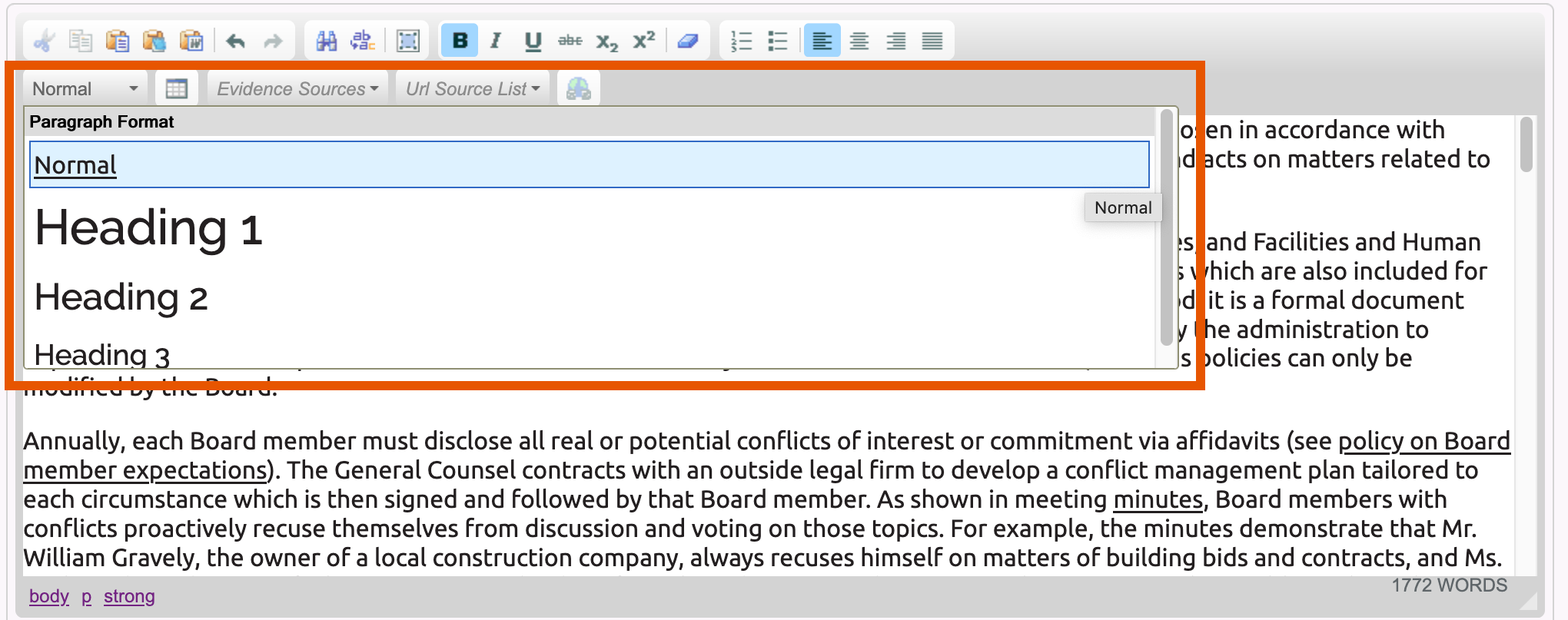

Insert Table
- Place the cursor at the point where the table should be added.
- Click on the Table button.
- Adjust the settings in the Table Properties window as needed and click “OK.”
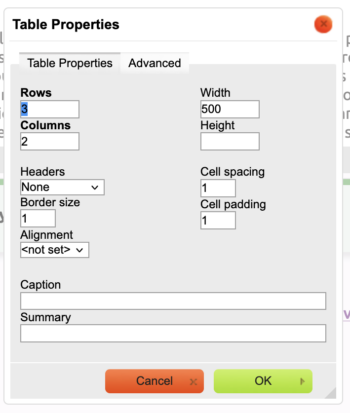
- The blank table will be added to the Argument field. Enter text to the table cells as needed.
To edit the properties of an existing table, right-click anywhere in the table. That will open a menu where users can:
- Insert, delete, merge or split cells.
- Change the text alignment, background color or properties of an individual cell.
- Insert or delete rows or columns.
- Edit other table properties, including the width or alignment.
- Delete the table.
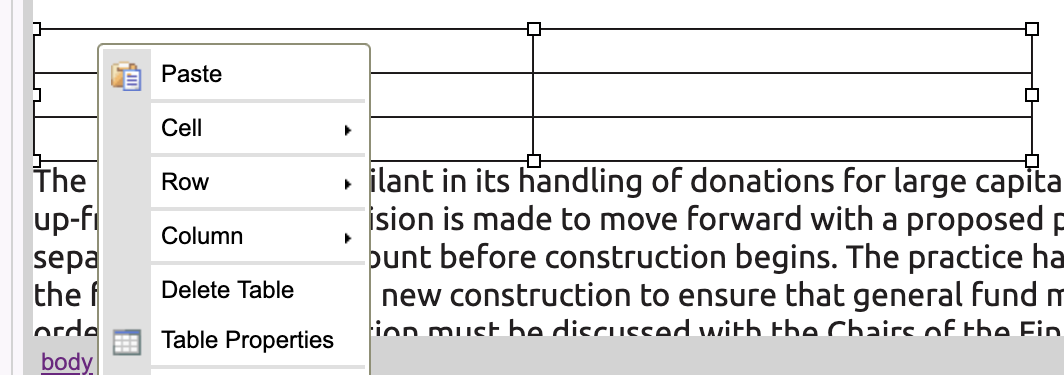
Tips for Formatting Data Tables
- Provide complex tables as PDF files. Because the formatting options for tables in the text field are limited, HLC encourages institutions to provide complex tables as PDF files in the Evidence File. Only simple tables should be entered directly into the text field.
- Set table width as a percentage of text field width. The default table width is 500 pixels. Change the width to a percentage to help ensure the table is displayed more consistently on different screen sizes and in exports of the Assurance Argument. For example, enter “100%” if you want the table to span the full text field, “50%” if you want the table to span half the width of the text field, etc.
- Set header rows or columns. Include a header row or column (or both, if applicable) to make the table more accessible for people who use screen readers. Set the table header in the Table Properties window.
Word Count
The total running word count of the Assurance Argument is displayed above the welcome message section, to the right of the status key. Word counts are also displayed for each section.
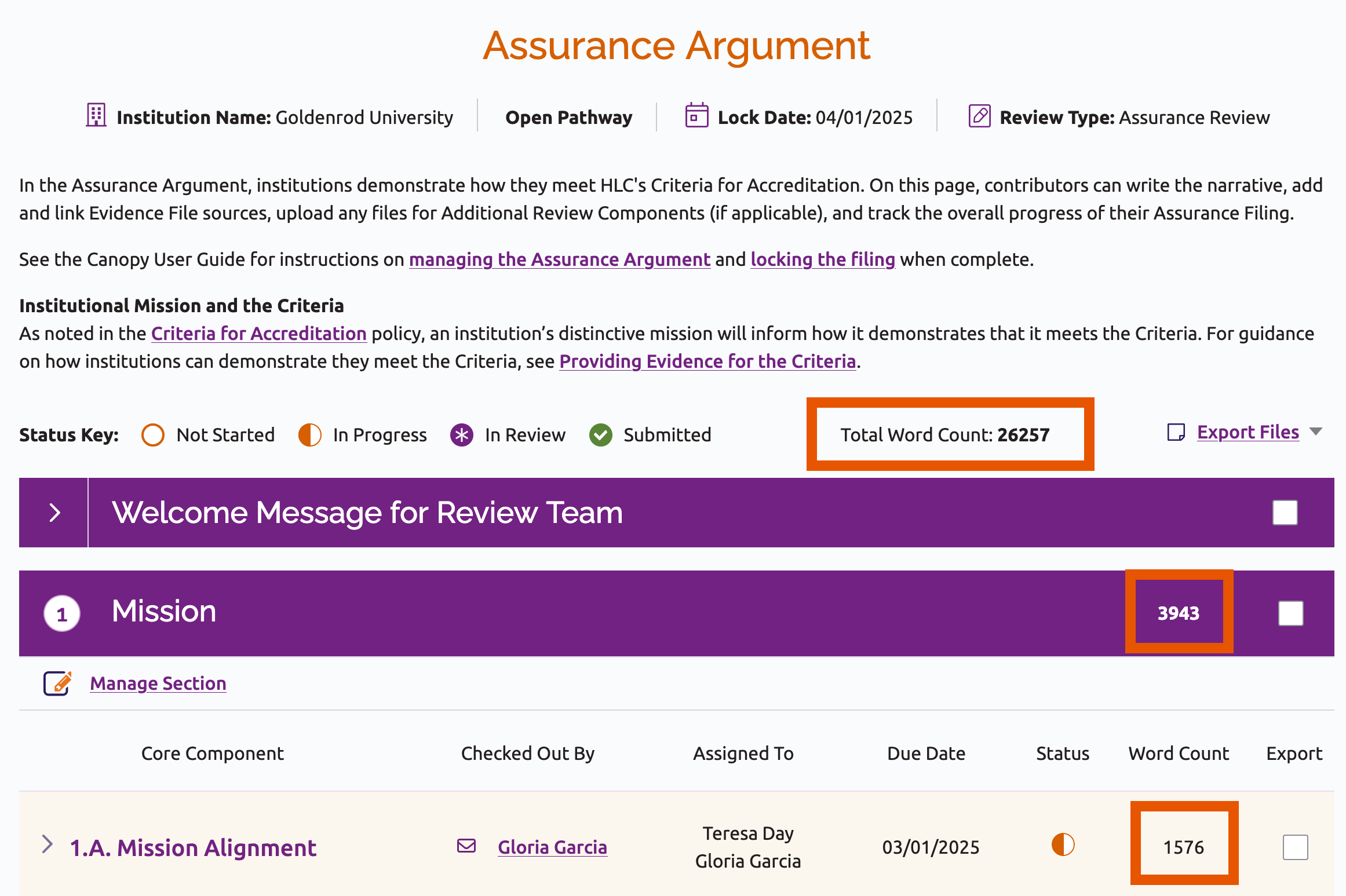
Word Count Limits
The system sets certain word limits depending on the institution’s pathway or review type. Specific limits are listed below. If the limit is exceeded, the word count will change to a red font but will not prevent users from adding more words to the Assurance Argument. Institutions should not exceed the word limit without checking first with their HLC staff liaison.
- Open Pathway Assurance Reviews and comprehensive evaluations: 35,000 words
- Standard Pathway comprehensive evaluations: 40,000 words
- Comprehensive evaluations for candidacy or initial accreditation: 40,000 words
- Comprehensive evaluations for Probation or Show-Cause: 40,000 words
Note: Institutions completing an abbreviated filing for a preliminary peer review should limit their narrative to 1,500 words for each Criterion summary section.
Export the Assurance Argument
All users, including readers, may export the entire Assurance Argument or individual sections as a PDF file or Microsoft Word document.
Note: If the institution uploaded an image to the Welcome Message, it will not be included in the export.
- Select the sections you wish to export.
- To select individual sections, click the checkbox to the right of each individual Criterion or Core Component section.
- To select the entire Assurance Argument, click “Export Files” at the top of the Assurance Argument page and check the box next to “Select all.”
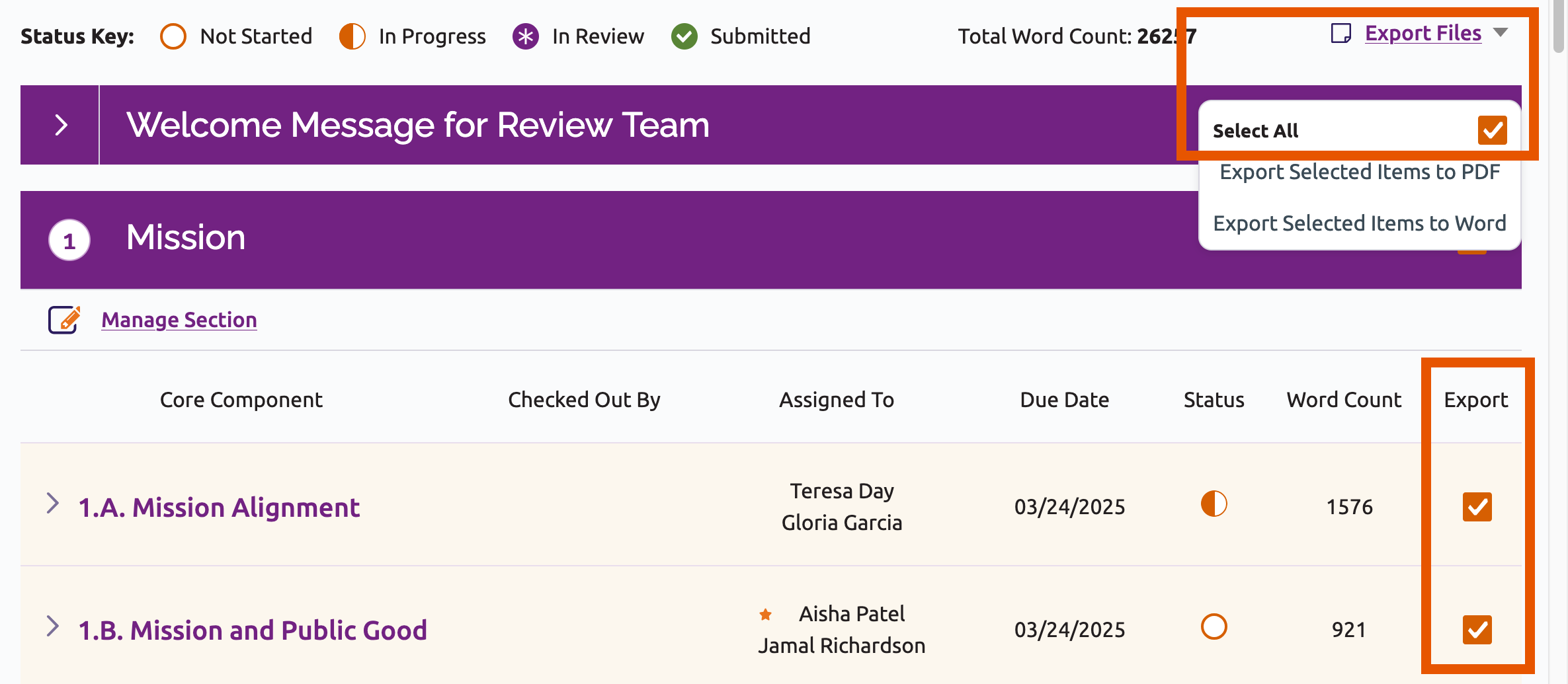
- Click “Export Files” at the top of the Assurance Argument page and click the link to export the files in your preferred format, either as a PDF or Word (.doc) document.
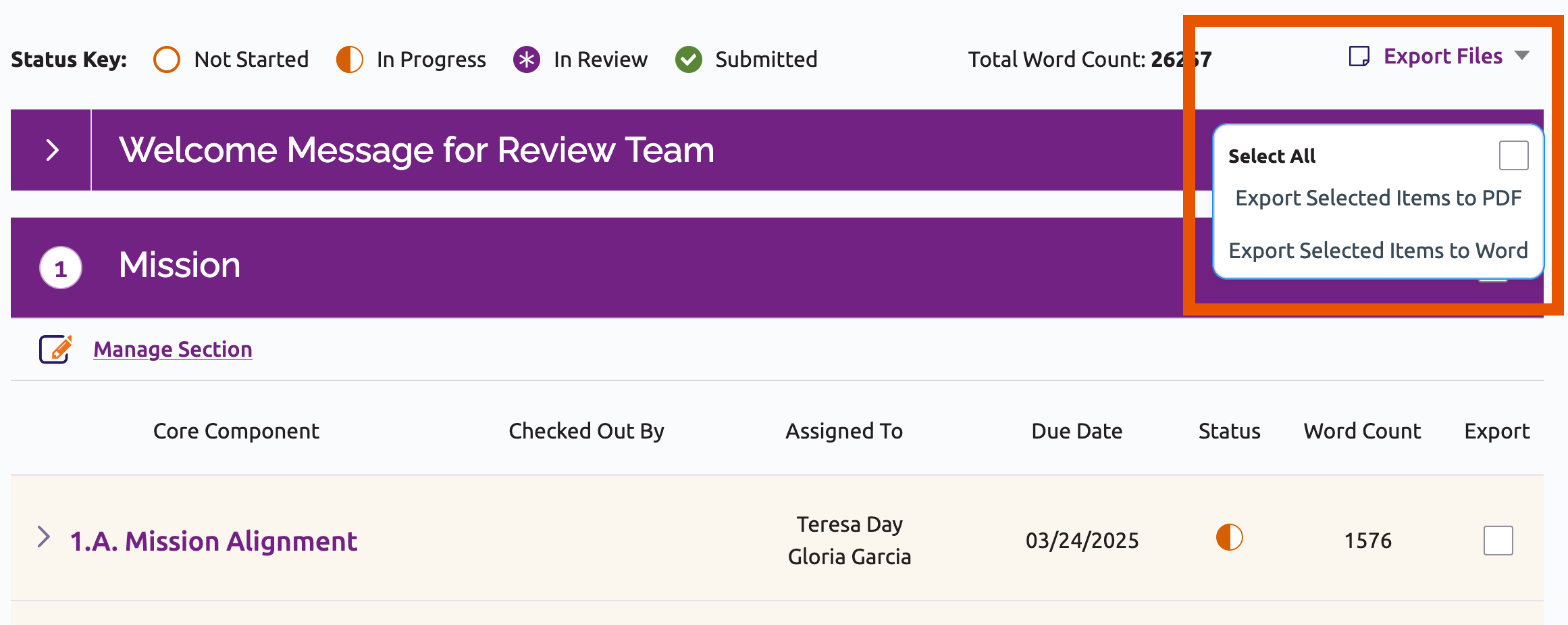
- You will see a message indicating that the file is being prepared.
- Click the provided link when the document is ready to download.
Additional Review Components (Forms)
An institution may be required to submit additional forms or reports related to additional review components, including the following:
- Federal Compliance Review
- Multi-campus Visit
- Embedded Change Visit
- Compliance With the Assumed Practices
- Compliance With the Eligibility Requirements
- Institutional Data Form
Upload Documents for Additional Review Components
If any additional review components are required, they will be added to the Assurance Argument section approximately six months prior to the institution’s lock date. Contributors will see an “Additional Review Components” section at the bottom of the Assurance Argument page. Institutions unsure whether any forms are required as part of their review should contact their HLC staff liaison.
All materials for additional review components must be completed and uploaded to the system prior to the lock date.
- Review the instructions listed for each component and, if applicable, click the Download Form button to access the most recent version of the related form.
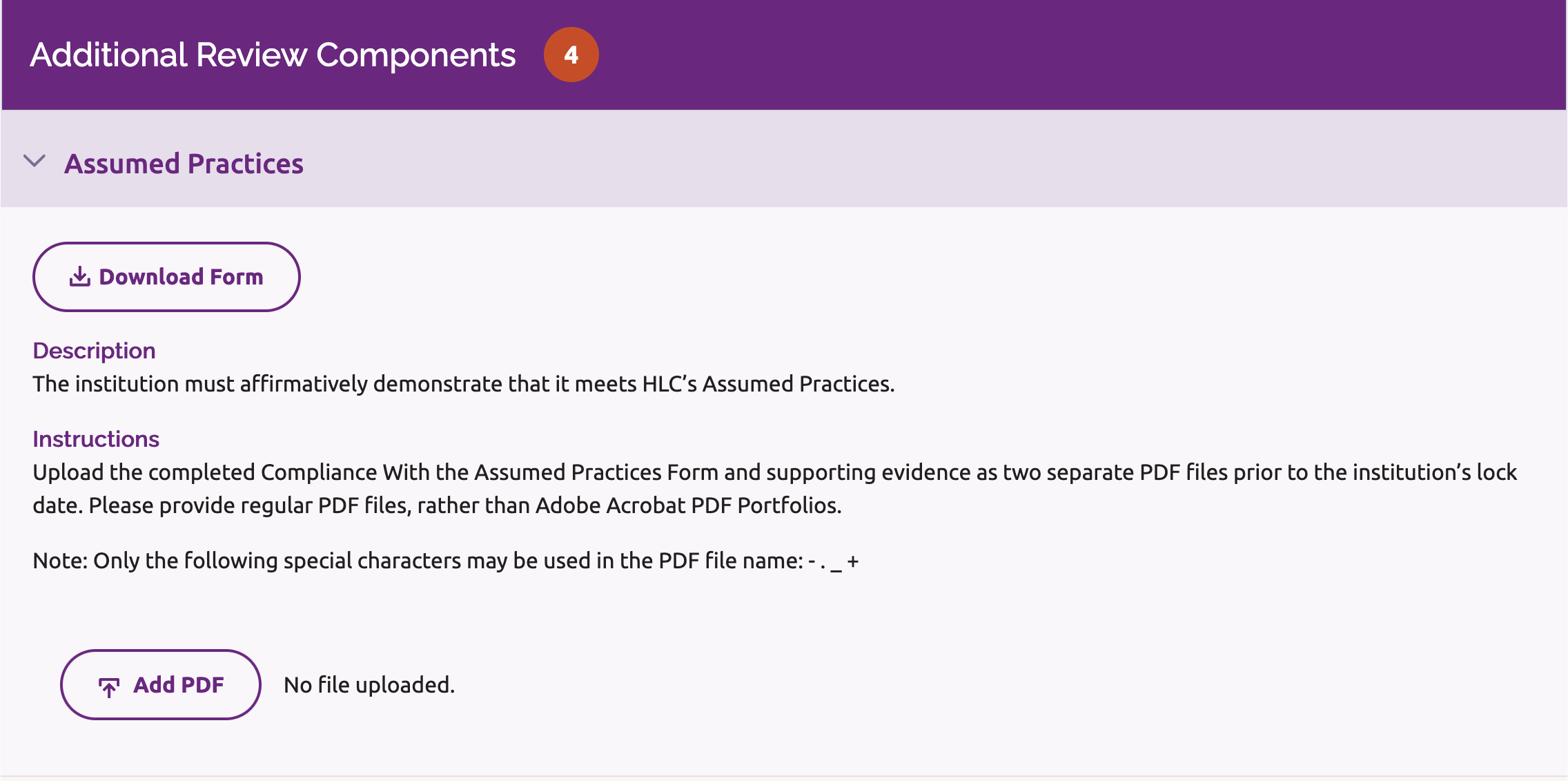
- Complete each form or report outside of Canopy and save it as a PDF document. Follow HLC’s instructions for formatting and saving materials for each form or report.
- Return to the Additional Review Components section in Canopy. Click the Add PDF button and browse to the document in the dialog box that opens.
- Note: File names can only include certain special characters: hyphen (-), period (.), underscore (_) or plus sign (+). Users will not be able to upload files that have other special characters in the file name, such as commas, question marks or slashes.
- Select “Open.”
Continue uploading documents as necessary for all required components.
Assurance Filing Instructions
User Guide Topics
All Users
Institutions
Peer Reviewers
Peer Corps Applicants

Related Resources

Questions?
Submit a Canopy Help Request
